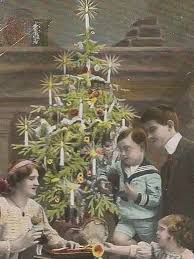
The following is taken from the Democrat and Chronicle December 25, 1901.
(120 years ago!)
What would the children of to-day do without their Christmas tree? That is a question few of the happy favored youngsters of the 20th century could answer satisfactorily, and it suggests a condition they could not face with equanimity. The holiday season, indeed, would lose half its significance to them, if not to their elders, with no tree.
Yet, like many other things of to-day, the Christmas tree was an institution practically unknown to the children of Rochester sixty years ago. Such a creation as the modern child enjoys, with its glittering ornaments, its myriad tiny colored tapers, or, even more up to date, its twinkling electric lights, to say nothing of its wealth of gifts, would have seemed nothing short of a gift from some good fairy’s wand. It would have been a thing to approach reverently, to gaze upon in wondering amazement and to treasure in the heart as a sacred memory.
It has within the recollection of one of Rochester’s oldest inhabitants when the first Christmas tree known in this city was exhibited. It was the venerable and honored George Ellwanger, of Mt Hope Avenue, who introduced it here.

“The Christmas tree was a German institution,” said Mr. Ellwanger in relating the story to a Democrat and Chronicle reporter. “We always had it in every Christian family in the Fatherland. It was the Christmas of 1841 or 1842, I don’t just recollect which, that we had a tree in the old German Lutheran church on Grove Street. We invited everyone who had never seen a Christmas tree, and explained its meaning to them. It was a big green tree, all lighted up with candles, and the people were amazed and very much pleased at its appearance. We had an address on the occasion, telling of the custom, especially directed to the children. After the first tree, the custom became a yearly one, and from it has developed to the elaborate and beautiful tree with which children of the present generation are so familiar.”

